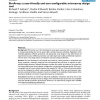Free Online Productivity Tools
i2Speak
i2Symbol
i2OCR
iTex2Img
iWeb2Print
iWeb2Shot
i2Type
iPdf2Split
iPdf2Merge
i2Bopomofo
i2Arabic
i2Style
i2Image
i2PDF
iLatex2Rtf
Sci2ools
BMCBI
2006
2006
SimArray: a user-friendly and user-configurable microarray design tool
Background: Microarrays were first developed to assess gene expression but are now also used to map protein-binding sites and to assess allelic variation between individuals. Regardless of the intended application, efficient production and appropriate array design are key determinants of experimental success. Inefficient production can make larger-scale studies prohibitively expensive, whereas poor array design makes normalisation and data analysis problematic. Results: We have developed a user-friendly tool, SimArray, which generates a randomised spot layout, computes a maximum meta-grid area, and estimates the print time, in response to userspecified design decisions. Selected parameters include: the number of probes to be printed; the microtitre plate format; the printing pin configuration, and the achievable spot density. SimArray is compatible with all current robotic spotters that employ 96-, 384- or 1536-well microtitre plates, and can be configured to reflect most production e...
| Added | 10 Dec 2010 |
| Updated | 10 Dec 2010 |
| Type | Journal |
| Year | 2006 |
| Where | BMCBI |
| Authors | Richard P. Auburn, Roslin R. Russell, Bettina Fischer, Lisa A. Meadows, Santiago Sevillano Matilla, Steven Russell |
Comments (0)

